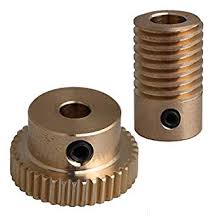The steel is used for high strength worm gears (worm wheel) and steel may be plain carbon steel or alloy steel. The metal gears usually are heat treated in order to combine properly the toughness and tooth hardness.
The phosphor bronze is widely used for worms drive as a way to reduce wear of the worms which is excessive with cast iron or steel.
Worm gear sets are usually used to reduce speed and maximize torque. Since the worm drive undergoes more contact anxiety cycles than the worm equipment, the worm travel is often of a more robust material.
• Cast iron provides strength and simple manufacture.
• Cast steel provides less complicated fabrication, strong doing work loads and vibration resistance.
• Carbon steels are economical and good, but are susceptible to corrosion.
• Aluminum is employed when low equipment inertia with some resiliency is necessary.
• Brass is inexpensive, easy to mold and corrosion resilient.
• Copper is easily formed, conductive and corrosion tolerant. The gear’s durability would maximize if bronzed.
• Plastic is inexpensive, corrosion resistant, tranquil operationally and will overcome missing teeth or misalignment. Plastic material is a smaller amount robust than steel and is susceptible to temperature alterations and chemical corrosion. Acetal, delrin, nylon, and polycarbonate plastics are common.
This 
The manufacturing methods of worms are roughly divided among cutting, heat treated and ground after cutting and rolling. And for worm wheels, they can be approximately divided among cutting tooth, cutting pearly whites after casting, and the teeth cutting after the outdoors rim is certainly cast around the guts of the blank.